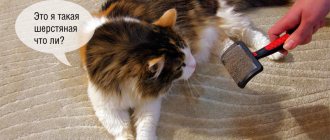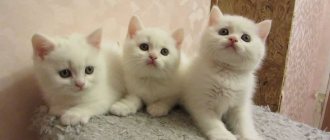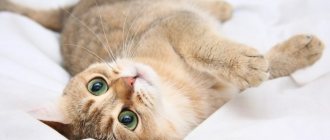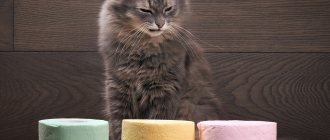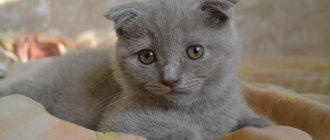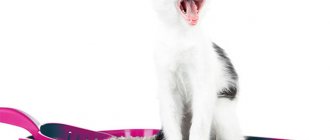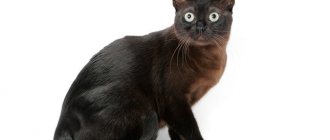Alena Igorevna Goncharenko
veterinarian Petstory
Constipation in cats is a fairly common problem with which owners go to the veterinary clinic. Normally, bowel movements should occur on average once every 1-1.5 days. Your cat's absence of stool for longer than this is a reason to suspect constipation and contact a veterinary clinic to determine the cause.
- Feed and food additives
What is considered constipation?
Constipation (constipation) - irregular bowel movements with increased intervals, the feces are dry and dense. Chronic and episodic constipation can be distinguished. Chronic refers to regular or recurrent episodes of difficult bowel movements. Constipation is called episodic if it happened once and after solving the problem did not recur. Older animals with other chronic diseases are more susceptible to chronic constipation. Episodic constipation can happen at any age.
A varied diet is the basis for good digestion and well-being
Poor nutrition is often the cause of constipation and other health problems. Many owners begin to feed their pets exclusively meat, such as tenderloin, or fish. Eating only dry food also has a bad effect on the predator’s body.
Try to imagine what a cat's diet looks like in the wild. She catches mice and birds and eats them whole, naturally, without choosing fillets from the prey. Meat, bones, skins, and the contents of the stomach and intestines of rodents or other animals enter the cat’s stomach. And in the intestines of the vole mouse there are semi-digested spikelets, which the cat itself cannot digest, but absorbs useful substances from them after digestion by the mouse.
The owner cannot feed the cat selected mice that have previously eaten environmentally friendly, tasty spikelets. But you can try to bring the diet closer to natural. Cats should receive not only meat products, but also grains and vegetables in a form that they can digest. People don't eat only sausage or red fish. A cat's menu should include different foods.
Causes of constipation
Nutrition
Nutrition plays an important role in regular bowel movements. Most often, problems arise with unbalanced natural feeding, the so-called “natural” feeding. It is simply impossible to balance a natural diet for a cat on your own; nutrition must meet at least 56 points of various indicators: energy value, proteins, fats, carbohydrates, vitamins, minerals and amino acids. In order for your pet to have enough of everything for a quality life, such a diet should be prepared by a specialist nutritionist. Constipation generally occurs when the diet is high in protein and low in fiber. But an unbalanced diet is especially dangerous for kittens. On such a diet, they are often diagnosed with nutritional hyperparathyroidism - this is a disease due to which calcium leaves the bone tissue into the blood, the bones become thin and brittle. The kitten experiences constant pain and cannot take a position suitable for defecation.
When feeding a dry commercial diet, constipation is also to be expected if the animal drinks very little water. To form stool of the correct consistency, there must be enough water in the intestines. If there is not enough water, the feces will be dry and hard at the exit, the frequency of bowel movements will be reduced, and the animal will experience pain when going to the tray.
This also includes feeding foods that are not at all suitable for cats (for example, bones). In general, a cat's stomach is capable of digesting small bones, but there are many cases of surgical removal of bones from the intestines. The bones can not only get stuck and cause constipation and obstruction, but also lead to perforation of the intestines, that is, simply tearing it in some part.
Hairballs
Hairballs in the intestines can also lead to obstruction and constipation. Long-haired cat breeds are especially prone to this, as well as cats that groom themselves excessively. Normally, hair should come out naturally, but if too much of it gets in, it can cause various problems. Most often, large hairballs remain in the stomach; this can manifest itself as periodic vomiting without deterioration in general well-being. But the fur can also travel further through the intestines, and especially dense clumps can simply stop in the small part of the intestine.
Parasites
This cause of constipation is relatively rare. The main problem is that large numbers of worms can curl up and become lodged in the small intestine. Street animals and animals without regular parasite treatment are prone to this. This condition can be extremely life-threatening. In addition to the fact that the cat is unable to empty its intestines and experiences pain at the site of obstruction, a large number of helminths cause general intoxication of the body. It is also necessary to take into account that if you independently give your cat a drug against helminths, this may lead to a deterioration in health due to the massive death of parasites, but will not solve the problem of constipation.
Diseases
A considerable number of different diseases can lead to the development of constipation in cats. These include the following:
- Chronic renal failure
The appearance of constipation in kidney disease is mainly associated with general dehydration, that is, a decrease in the amount of fluid in the body. The animal itself is dehydrated - becomes dehydrated, dry and hard and feces. Additional symptoms in a cat include periodic vomiting, decreased appetite, weight loss, and increased drowsiness.
- Tumors
The presence of bulky tumors mechanically interferes with the movement of feces through the intestines. Tumors can be either in the intestinal lumen itself, that is, closing the passage for feces, like a plug, or in the area of other abdominal organs, while squeezing the intestine from the outside with its size. Vomiting will also be noted; it can be either rare, periodic, or repeated, incessant. The animal will feel pain of varying degrees of intensity, will be more lethargic, and appetite will decrease. Enlarged superficial lymph nodes may be palpable.
- Neurological disorders
Various diseases in the nervous system can lead to disruption of the innervation of the intestines, as a result of which peristalsis, due to which masses move through the intestines, decreases or completely disappears. This often happens due to injuries in the lumbar spine, vertebral fractures, compression of the spinal cord and spinal nerve roots. The sensitivity of the pelvic limbs may be impaired or there may be a complete lack of support on them.
- Anatomical defects of the pelvic bones
An abnormal anatomical structure of the pelvis can also lead to constipation. This condition can be congenital if the fetus was malformed in utero for some reason or has genetic abnormalities. This may also be a consequence of a fracture and improper fusion of the pelvic bones: for example, if the cat was hit by a car or fell from a height, and he was not provided with qualified assistance. The space between the pelvic bones into which the rectum emerges turns out to be too narrow, and feces simply do not pass into it.
- Mechanical obstruction
Cats are big fans of eating inedible objects. Large, dense objects, such as balls and mouse toys, quite often end up in the cat's stomach and then get stuck in a narrow part of the intestine. A mandatory symptom in this condition will be vomiting, most often multiple times, especially after trying to eat or drink.
- Orthopedic diseases
Various diseases of the musculoskeletal system (for example, arthritis, chondrodysplasia of Scottish cats, etc.) lead to the inability to take a comfortable position due to pain. The cat has to endure the urge to defecate, since the desired position in the litter box causes even more painful sensations. It will be difficult for your pet to jump onto high surfaces; sometimes cats cannot even jump over the side of the tray.
- Megacolon
This is a state of prolonged increase in the volume of the colon and a decrease in its peristalsis. It can be either congenital or occur due to existing long-term constipation. In this condition, feces accumulate in the intestinal lumen for a long time, become dehydrated and become denser.
- Anal atresia
A congenital anatomical defect, which consists in the absence of the anus and, accordingly, the inability to defecate. The large intestine ends blindly in the abdominal cavity, and feces simply remain in it.
Constipation after sterilization
Sterilization can also cause constipation. Anesthesia drugs or painkillers may be to blame. Also, a decrease in general activity after surgery slows down bowel function. The absence of stool up to 3-4 days after sterilization is not something terrible. However, there are also postoperative complications such as adhesions (this is a pathological growth of connective tissue between organs or in the walls of the organs themselves). They can interfere with the normal functioning of the intestines, squeeze it, and prevent it from contracting.
Hurry up, choose a box and find out what gift awaits you
Discount on pet insurance
Promo code copied to clipboard
Choosing a laxative for a cat
Laxatives help relieve constipation, but their uncontrolled use can lead to unwanted effects. Let's look at the main types of medications and traditional medicine recommended by practicing veterinarians.
Medications
Based on its composition and type of effect on the animal’s body, cat laxatives are divided into several large groups.
- Bulk-forming laxatives.
- Osmotic laxatives.
- Lubricants.
- Stool softeners.
- Laxatives with a stimulating effect.
- Enema.
Bulk-forming laxatives
These are drugs that pass through the cat’s gastrointestinal tract in an undigested state. In the large intestine, they expand due to the absorption of water - the animal’s stool becomes softer and larger. This group of drugs has a long period of action - from 12 to 72 hours. Drinking plenty of fluids is prescribed for the entire course of taking the drug.
Indications: chronic constipation and its prevention; irritable bowel syndrome, hemorrhoids, anal fissures, pregnancy.
Dosage: 0.5 teaspoon for each meal. The dose of the drug is gradually reduced.
You should not give it: if the animal requires emergency help, it is better to use another type of means.
Contraindications and side effects: individual intolerance and allergic reactions. They affect the absorption of other drugs.
Recommended drugs:
- Metamucil (Metamucil),
- preparations based on flax seed.
Osmotic laxatives
This type of medication works by pulling water from the cat's body into the large intestine. Therefore, while taking them, it is necessary to monitor compliance with the drinking regime - the cat should drink a lot. The increased volume of feces with the help of liquid puts pressure on the intestinal walls, causing the urge to defecate.
The composition of osmotic laxatives is based on lactulose, which acts at the level of the colon. Lactulose suppresses the growth of pathogenic flora and forms beneficial intestinal microflora. The laxative effect occurs within 24-48 hours.
Indications: acute and chronic constipation, dysbacteriosis, postoperative period (sterilization).
Dosage: 0.5 ml per 1 kg of live weight 2-3 times a day.
Should not be given: for emergency use.
Contraindications and side effects: chronic renal failure. With prolonged uncontrolled use - loss of electrolytes, dehydration.
Recommended drugs:
- Lactusan (syrup or tablets);
- Duphalac (powder or syrup).
Lubricants
Preparations with a lubricating effect are most often used to combat hairballs. So-called malt pastes lubricate the intestinal walls, facilitating the natural removal of hairballs from the body. The composition of lubricants includes vitamins: A, E, D.
Recommended drugs:
- GimCat Malt-Soft Paste Extra;
- Beaphar Malt Paste;
- TRIXIE Malt'n'Grass.
This group of laxatives also includes vaseline oil and products based on it. The oil included in their composition envelops the intestinal walls, helping to remove foreign bodies, bezoars, and hard stones.
Vaseline oil is a safe and gentle product. It is not absorbed, does not accumulate in the body, and does not cause allergic reactions. Once in the cat's body, the oil creates a slippery film on the intestinal walls. This helps to naturally remove accumulated stool. Vaseline film prevents toxins from being absorbed and prevents the development of intoxication in the animal’s body. The laxative effect occurs after 3-6 hours.
Indications: episodic constipation, postoperative period (sterilization/castration, abdominal surgery), postpartum period, coprostasis.
Recommended dosage: 1 ml of oil per 1 kg of live weight after 8-10 hours.
Should not be given: for chronic constipation.
Contraindications and side effects: intestinal bleeding, hemorrhoids in the acute phase. In case of long-term use, the reflex to defecation may decrease. Reduces the absorption of fat-soluble vitamins (A, D, E).
Recommended drugs:
- Bimin;
- Vaseline oil.
Stool softeners
The effect of the drugs is due to the salts included in their composition. They reduce the surface tension of the animal's stool, allowing it to better absorb water. Emollients can be used very carefully, only as directed by a veterinarian (prescription). The effect occurs within 3-6 hours.
Indications: intoxication, episodic functional constipation, bowel cleansing before abdominal surgery (sterilization).
Dosage: strictly as prescribed by the doctor.
Do not give: if the cat requires long-term treatment.
Contraindications and side effects: pregnancy, lactation. With prolonged uncontrolled use - an uncontrollable laxative effect.
Recommended drugs:
- Docusate sodium is a fast-acting laxative.
Laxatives with a stimulating effect
Stimulant laxatives act by irritating the muscles of the colon, thereby increasing its activity. Prevents hardening of feces. They are characterized by fast action. Prescribed by a veterinarian. The effect occurs 6-10 hours after administration. The duration of use should not exceed 7-10 days. Uncontrolled use may cause dehydration.
Indications: acute constipation.
Dosage: calculated individually by a veterinarian.
Should not be given: for chronic constipation.
Contraindications and side effects: pregnancy, lactation. With prolonged uncontrolled use, “lazy” bowel syndrome is formed, chronic constipation develops, and the risk of tumors in the colon increases.
Recommended drugs:
- Bisacodyl is a strong laxative.
Enema
A cleansing enema helps clear the cat's intestines of stagnant fecal matter. An enema is done with warm boiled water or chamomile infusion. It is best not to do it yourself at home, but to entrust this procedure to specialists.
Important!
Human laxatives are not suitable for cats.
Folk remedies
In addition to medicines, the following are used in folk medicine:
- Pumpkin. Freshly squeezed natural pumpkin juice is a natural laxative for cats. The juice is mixed into food or poured into the animal’s mouth using a syringe. The recommended single dose is 0.5 teaspoon. As a preventive measure, a little boiled pumpkin is included in the animal’s daily diet. For convenience, boil the peeled pumpkin for 7-10 minutes and grind in a blender to a puree.
- Milk. The most common folk remedy with a laxative effect. Milk is given warm several times a day. Do not give to cats with lactose intolerance. In large quantities it can cause diarrhea.
- Condensed milk. Condensed milk diluted with raw water (from the tap) acts as a laxative. Condensed milk is diluted with water in a ratio of 1:3. The resulting mixture is given to the cat one tablespoon at an interval of 3-4 hours, no more than 5 times a day. This method should not be abused. This method is not used in cats with diabetes.
- Olive, flaxseed and coconut oil. A small amount of oil (¼ – ½ teaspoon) is mixed into the animal’s food. Vegetable oils should be given in doses and with great caution - they negatively affect liver function.
- Psyllium seed husk is a natural enterosorbent that restores intestinal microflora. The husk is crushed in a coffee grinder or blender and mixed into cat food, ¼ - ½ teaspoon per meal.
- Unhulled oat grains have a mild laxative effect. Add 50 grams of grains to a glass of milk and boil for 30 minutes. Cool the finished broth to room temperature and give a teaspoon 2 times a day.
- Oat bran is a good source of fiber, an analogue of the drug Metamucil. Give half a teaspoon with each meal. Long-term use is allowed.
- Decoctions and infusions of herbs: rhubarb root, buckthorn, borage, knotweed, elderberry, flax seed, centaury. A tablespoon of dry herb is poured into a glass of boiling water and left in a water bath for 20 minutes. The resulting broth is cooled for half an hour, filtered, squeezing out the raw materials. Bring the infusion to 200 ml by adding warm boiled water. Give 1-2 teaspoons 3-4 times a day.
If the cat does not have a bowel movement within 8-12 hours after taking the folk remedy, it must be taken to a veterinarian for a diagnosis and treatment.
Herbal remedies for constipation
Collection No. 1
- Peppermint leaves – 1 part;
- Pharmaceutical chamomile – 1 part;
- Stinging nettle – 1 part;
- Horse sorrel – 1 part.
Collection No. 2
- Buckthorn bark – 3 parts;
- Stinging nettle – 2 parts;
- Yarrow – 1 part.
Herbal teas are prepared and used in the same way as herbal decoctions.
Important!
According to veterinarians, it is better not to use vegetable oils. They are absorbed into the intestines and cause pain. An overdose of vegetable oils causes problems with the liver.
How to help kittens with constipation
A kitten's unstable digestive tract can react by delaying bowel movements to the slightest error in nutrition. The normal stool frequency for kittens is at least once a day. If you notice signs of constipation: hard feces, painful bowel movements, hard belly, you should:
- find the reason
- perform a first aid.
To determine the cause, the kitten is shown to a veterinarian. Before visiting the clinic, you can use one of the following proven methods:
- drink milk or condensed milk diluted in raw water;
- adjust the water balance, offer the kitten something to drink, and if it refuses, give it something to drink using a syringe;
- massage the tummy with light longitudinal movements from the chest to the tail, it is best to do this with a moistened cotton pad - this is reminiscent of the licking of a mother cat;
- give vaseline oil - 0.5 ml per 1 kg of weight 2-3 times a day;
- make an enema with chamomile infusion using a small syringe or syringe (10 ml) - lubricate the tip with Vaseline;
- put a rectal suppository made from a small smooth soap soaked in water.
It is strictly prohibited to independently select medications for a kitten. All medications must be prescribed by a veterinarian.
Kittens are prescribed mild laxatives based on lactulose in powders or syrup with a safe effect.
Recommended drugs:
- Vetelact;
- Lactusan;
- Duphaston;
- Prelax.
The drugs are given orally using a syringe or mixed into milk. The powders are pre-diluted in a small amount of boiled water at room temperature. The recommended dosage for kittens is 0.25 ml per 1 kg of weight 2-3 times a day.
Laxative in the postoperative period
After sterilization (castration), due to the use of strong anesthetic drugs, the animal experiences difficulty in bowel movements. To prevent bleeding and suture dehiscence, the doctor prescribes laxatives and prescribes a special postoperative diet.
What to give?
To help your cat restore the process of defecation, you can use Vaseline oil or the laxative Duphalac in syrup. To do this, oil or medicine is drawn into a syringe without a needle at the rate of 0.5 ml per 1 kg of animal weight.
Symptoms of constipation in a cat
Owners can usually identify the symptoms of constipation in their cat on their own. You can note more rare bowel movements (once every 2-3 days or longer) or a complete absence of bowel movements. The stool may be small, drier, in the form of a thin ribbon or hard lumps. The cat may show anxiety when trying to defecate, meowing, or even screaming. At the same time, a cat will often and ineffectively run to the litter box during constipation in much rarer cases than during acute urinary retention; owners often confuse these conditions. Usually the absence of bowel movements is noticed only by a clean tray. A complete absence of bowel movements may indicate intestinal obstruction, most often the cause is the eating of foreign bodies, an accompanying symptom will be vomiting.
Feces in the form of a thin ribbon may be a symptom of the presence of a large mass in the abdominal cavity or intestines. A complete absence of the urge to defecate or rare involuntary defecation indicates pathology in the area of the nerves that innervate the intestines. Prolonged absence of defecation and accumulation of feces in the intestines lead to intoxication of the body, vomiting, refusal to eat, and general depression may begin. The abdomen may become hard and painful to the touch. Without help, the animal will eventually die.
What to feed a cat after surgery
To prevent constipation in your pet, you should know what to feed it after surgery.
There are a number of products that are recommended for cats that have undergone sterilization, as well as products that are extremely undesirable to include in your pet’s menu during the rehabilitation period.
Recommended Products
- boiled fresh vegetables (zucchini, cauliflower, pumpkin);
- fresh fermented milk products (yogurt, yogurt or kefir);
- lean boiled fish;
- raw liver (in small quantities);
- buckwheat porridge.
After sterilization, it is recommended to give the cat fermented milk products.
Contraindicated products
- raw or boiled eggs, especially the yolk;
- meat broths and fatty meats (pork or lamb);
- rice porrige;
- boiled offal (liver, heart, kidneys);
It is not recommended to give boiled offal to a cat after sterilization. These foods are more likely to cause constipation.
- fresh milk;
- dry food.
You cannot feed dry food after sterilization.
Some animals after sterilization may refuse food for two or three days and drink only water . This is quite normal and if the cat does not have problems with the toilet, then there is no reason to worry.
In most cases, a properly designed menu during the rehabilitation period reduces the risk of constipation.
A properly selected menu reduces the risk of constipation.
Diagnostics
To diagnose and establish an accurate diagnosis, various techniques will be required. First of all, the doctor will collect a detailed life history: how old the animal is, a detailed diet, treatment for parasites, past diseases, living conditions. Next, you will need a medical history: what exactly is bothering you, how long ago it happened, what the stool looks like, and whether there are any other complaints besides constipation. Then the doctor will examine the animal, perform palpation of the abdomen and rectal examination.
Additional research may be required. An abdominal x-ray will show the amount of stool in the intestines, contrast-enhancing foreign objects (for example, undigested bones) or evidence of non-contrast foreign bodies, mass formations, and dilation of the colon. An X-ray of the pelvic area will show whether there are any anatomical changes in the pelvic bones or improperly healed fractures. The doctor may also prescribe a study with the injection of a radiopaque contrast agent; it will show whether intestinal patency is preserved. An ultrasound of the abdominal cavity will show the presence of neoplasms, inflammatory processes in the intestines, and will help assess whether peristalsis in the intestines is preserved in various sections.
General clinical and biochemical blood tests can also help make a diagnosis (for example, kidney disease). A stool test can show the presence of parasites. In rare cases, computer or magnetic resonance imaging or rectocolonoscopy may be indicated.
Treatment of constipation in cats
What to do if you are experiencing constipation in your cat? First, you need to contact a veterinary clinic and establish the exact cause, since self-treatment can be not only ineffective, but also dangerous. There are various medications, nutritional supplements and procedures that are used for treatment.
Laxatives:
- Osmotic (lactulose, saline laxatives). Their principle of action is based on increasing the osmotic pressure in the intestinal lumen, due to which water from the intercellular spaces rushes into it and softens the feces;
- Prokinetics (domperidone, prucalopride, metoclopramide) are designed to stimulate intestinal motility and improve mass movement;
- Emollients (vaseline oil) help soften stool and promote better glide through the intestines.
Feed and food additives
There is a line of special veterinary diets that are designed to treat chronic constipation in cats. Foods such as Royal Canin Gastrointestinal Fiber Response and Hill's Gastrointestinal Biome have proven themselves well. These diets contain a high fiber content, which is necessary for better intestinal motility. Also, dietary supplements such as wheat bran and psyllium can be used as an additional source of fiber.
Enema
It is not recommended to carry out such a serious procedure as a deep enema at home. Typically, a deep cleansing enema is prescribed in fairly advanced cases, and manipulation is carried out only under anesthesia. In less severe cases of constipation in cats and especially small kittens, a doctor may recommend treatment with a microenema (microlax).
Surgery
For conditions such as the presence of a foreign body in the intestine, voluminous tumors, megacolon, anal atresia, treatment is possible only in the form of surgery. Independent use of laxatives, enemas and other methods can lead to very negative consequences; the main complication is intestinal rupture with loss of contents into the abdominal cavity, peritonitis and death.
When to give a laxative
Before you give your cat medicine for constipation, you need to understand the cause of the difficulty in defecation. There is no need to grab a laxative as soon as it seems to you that your cat rarely goes to the toilet.
Sometimes owners panic in vain, mistakenly believing that the cat is constipated.
It happens that the animal was simply starving, so she does not have bowel movements.
Or the cat has just experienced stress: a move, a fright, the arrival of a new family member or pet.
Psychological constipation caused by rejection of the tray, filler or the pet’s stressful state can be treated without the use of laxatives.
In the first case, you need to create comfortable conditions for the cat to go to the toilet: choose a secluded place for the tray, select a litter.
In the second, eliminate the cause of stress, calm the animal, and take anti-stress medications as prescribed by the veterinarian.
Constipation that develops as a result of changing food or switching to a different type of food begins to be treated with the introduction of a special diet or switching to dietary food.
You can give your cat one of the traditional medicines for constipation: a decoction of medicinal herbs, freshly squeezed vegetable juice, milk or fermented milk products.
It is not recommended to give laxative medications without consultation with the treating veterinarian.
When to give:
- After sterilization or castration surgery.
- If the cat cannot go “big” for more than 3 days.
It is prohibited to give:
- If constipation is caused by swallowing inedible objects or bones.
- If there is mucus or blood in the stool.
If your cat needs an urgent bowel movement, use an enema. No other medicine has the same rapid effect.
